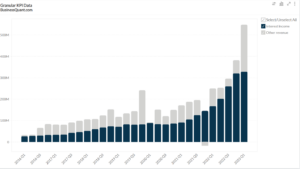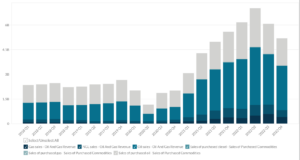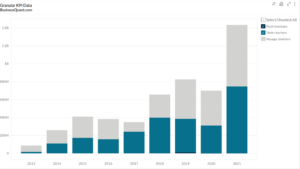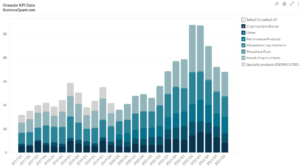
American Airlines’ Fuel Per Average Seat Mile (2016-2022)
Exclusive Data
You need the Pro Plan to access KPI data
- Full access to the platform
- KPI data & segment financials on US stocks
- Financial data on thousands of stocks
- Download data in xlsx and csv formats
Pro Plan
$49 per month*
60% discount ends in:
.
About
More information
Subscribe to Pro or Enterprise plans to unlock this feature.
Contact the Analyst
Subscribe to Pro or Enterprise plans to unlock this feature.
Become a smarter investor today.
Access KPIs & Segment Financials on US stocks
This statistic highlights American Airlines’ Fuel Per Average Seat Mile, reported on a quarterly basis from Q1 2016 onwards.
American Airlines is the major holding of AMR Corp. The airlines serve customers worldwide. They provide passenger and cargo services across the world. They operate a fleet of more than 1500 aircraft. Its services are divided into mainline and regional. The mainline segment accounts for almost two-thirds of the company’s revenue, the remaining comes from regional and cargo services. The mainline segment runs around 900 aircraft and the regional service runs 600 aircraft. They operate flights to and from South America, Canada, Africa, Asia, Australia, and Europe.
Fuel costs are one of the major costs for an airline. Fuel per average seat mile is one way of measuring the efficient use of fuel. The Fuel per average seat mile is obtained by dividing the fuel costs by available seat miles. The fuel per average seat mile currently for American Airlines is $3.51 and has increased from $ 2.25 4 years ago.
The fuel per average seat mile for the regional segment was $0.34 in the first quarter of 2016. After this, it started increasing and went to $0.39 in the second quarter, $0.42 in the third quarter and $0.47. The cost continued to increase in 2017 to $0.49 in the first quarter,$0.46 in the second quarter, $0.48 in the third quarter, and $0.57 in the fourth quarter. The cost increased to $ 0.60 in the first quarter of 2018, $0.64 in the second quarter, $0.67 in the third quarter, and $0.69 in the fourth quarter. The increase in 2019 was to $0.63 in the first quarter, $0.67 in the second quarter, $2.13 in the third quarter and $0.68 by the end of the year.
The fuel per average seat mile for the mainline segment was $1.58 in the first quarter of 2016 and then increased to $1.86 in the second quarter, $1.94 in the third quarter, and $2.03 in the fourth quarter. It further increased in 2017 to $2.18 in the first quarter, $2.10 in the second quarter, $2.15 in the third quarter, and $2.44 by the end of the year. The costs continued to increase in 2018 to $2.68 in the first quarter, $2.89 in the second quarter, $2.98 in the third quarter, and $2,86 by the fourth quarter. The fuel cost finally dropped slightly in 2019 to $2.59 in the first quarter, $2.76 in the second quarter, $2.03 in the third quarter, and $2.58 in the fourth quarter.
The fuel costs for the regional segment have been increasing constantly over the last four years. The costs have gone up each quarter as well. This is a big cause of worry for the company as their expenses are rising every year. The only positive from this data is that the fuel cost per average seat mile for the mainline segment started to reduce in 2019. The fuel costs are expected to go down in 2020 due to the reduced demand. The company needs to work on using its fuel more efficiently, not only to make profits but also to sustain the business.
Did you like American Airlines’ Fuel Per Average Seat Mile statistic?
Access more such KPI data points and segment financials on thousands of US stocks, with Business Quant.
You can get started here.
More data on US Stocks

Our Plans
Always know what you’ll pay. No hidden costs or surprises.
- Annual
- Monthly
60% discount till April 30
Pro
For serious investing
-
Company KPI data Access segment financials, non-GAAP metrics and KPI data from presentations and filings. Examples include financials by segment / region / product category, AT&T's broadband subscriber trends, Tesla's deliveries by model and lots more.
-
Stock research tools Features include : stock screener, stock comparison, industry financials, stock warnings, advanced charting tools, timeseries tables, scatter charts, financial statements, stock reports, SEC filings, stock ratings, institutional and insider ownership data. There are 200+ financial items and ratios on thousands of US stocks.
-
Industry data & tools Access premium operating data on 40+ industries. Examples include market share, smartphone shipments by vendor, subscribers by wireless carrier, historical gold production. There are 20,000+ such statistics.
Enterprise
For tailored workflows
-
All of Pro plan Get unfettered access to all our dashboards and dossiers.
-
Custom built features Get tailored dashboards built specially for you , based on your set of requirements, to simplify your research workflow.
-
Admin billing Back-end documentation support and multi-seat licensing.
* Billed annually, local taxes extra.
60% discount on Annual plan
Pro
For serious investing
-
Company KPI data Access segment financials, non-GAAP metrics and KPI data from presentations and filings. Examples include financials by segment / region / product category, AT&T's broadband subscriber trends, Tesla's deliveries by model and lots more.
-
Stock research tools Features include : stock screener, stock comparison, industry financials, stock warnings, advanced charting tools, timeseries tables, scatter charts, financial statements, stock reports, SEC filings, stock ratings, institutional and insider ownership data. There are 200+ financial items and ratios on thousands of US stocks.
-
Industry data & tools Access premium operating data on 40+ industries. Examples include market share, smartphone shipments by vendor, subscribers by wireless carrier, historical gold production. There are 20,000+ such statistics.
Enterprise
For tailored workflows
-
All of Pro plan Get unfettered access to all our features.
-
Custom built features Get tailored dashboards built specially for you , based on your set of requirements, to simplify your research workflow.
-
Admin billing Back-end documentation support and multi-seat licensing.
* Local taxes extra.






